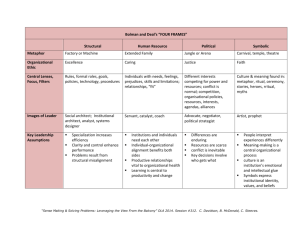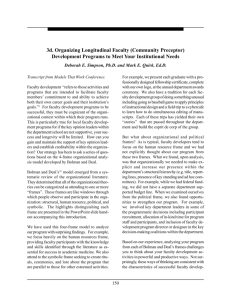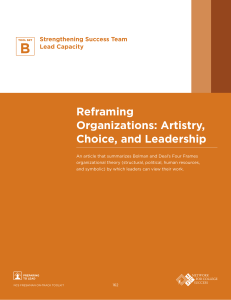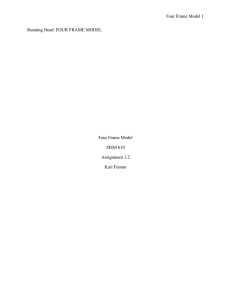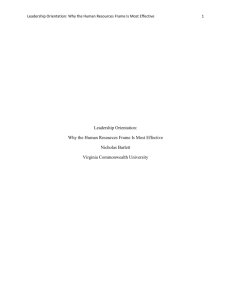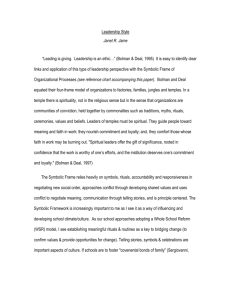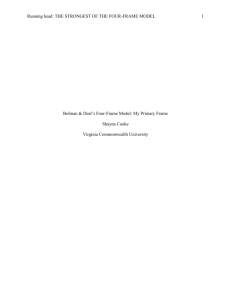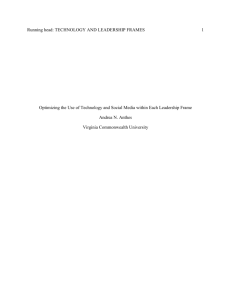Running head: LEADERSHIP THROUGH THE STRUCTURAL
advertisement
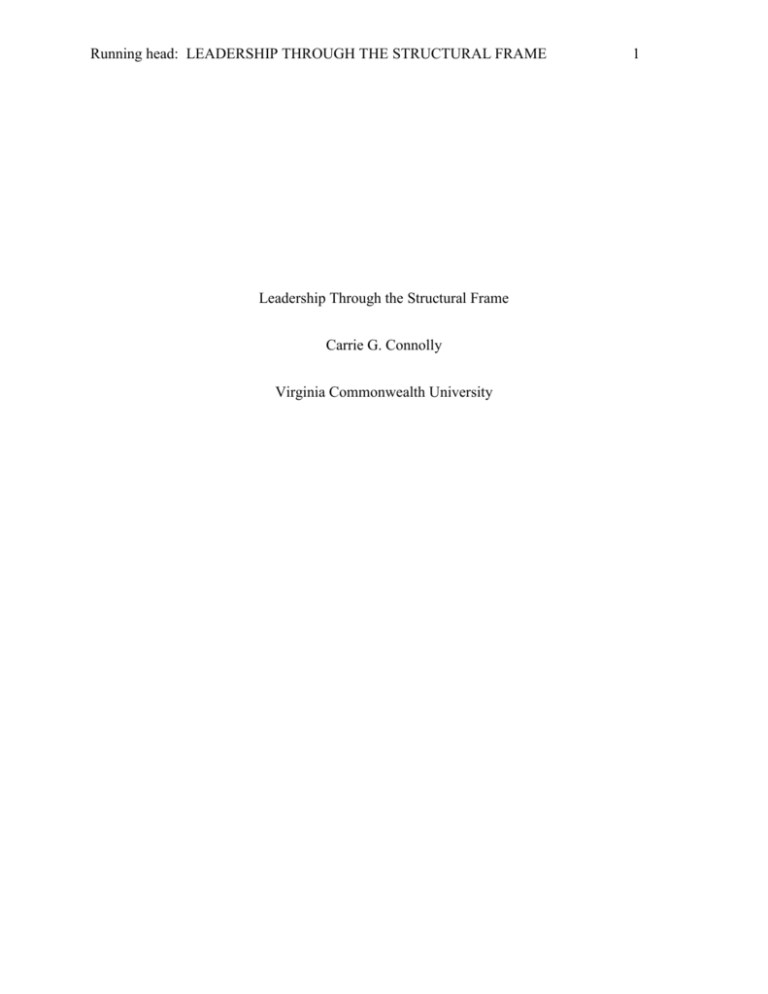
Running head: LEADERSHIP THROUGH THE STRUCTURAL FRAME Leadership Through the Structural Frame Carrie G. Connolly Virginia Commonwealth University 1 LEADERSHIP THROUGH THE STRUCTURAL FRAME Leadership Through the Structural Frame It is important for a leader to understand his or her leadership style in order to adapt to situations. Leadership style can be defined as an approach to leadership, which a leader actively chooses to take (Drath, 2001). Bolman and Deal (2008) suggest that in addition to understanding one’s leadership style, one must also understand the frame of leadership. A frame is a set of ideas of which a leader uses in situations to form his or her perspective and take action on the issue. Different situations may require different frames in order to work through the situation more efficiently, but every leader has a preference of frame (Bolman & Deal, 2008). The Structural Frame There are four frames of leadership: structural, human resources, political and symbolic (Bolman & Deal, 2008). The author has a preference for the structural frame. The structural frame uses ideas, such as facts, logic, organization, and analysis to lead. Leaders who use a structural frame enjoy making decisions when a clear structure or policy is in place to support the decision. A structural frame also ensures a high level of consistency in behavior as individuals use the same guidelines to formulate decisions and little discretion is needed (Bolman & Deal, 2008). The author finds comfort in having consistency in her strategic planning based on established policy and organizational goals. However, there are times when reframing is needed to adjust to the demands of a particular situation. Examples Critical thinking is needed in any level of leadership, but having the structural frame assists the author with making confident, well-informed and quick decisions that can be supported with facts. One responsibility the author has in her current work position is managing 2 LEADERSHIP THROUGH THE STRUCTURAL FRAME the admissions process for the Honors College. The eligibility requirements are clear and written out for all prospective students to read. Orientation sessions are also held by the author to answer questions or clarify requirements. The author’s leadership principle of personal dominance is exhibited during such sessions. Drath (2001) defines personal dominance as leadership where followers are convinced of the truth by the leader, who is using inner qualities to lead. During the orientation sessions, the author is confident in her abilities and her natural leadership style takes over. Her structural frame allows her to stay to the facts of the program and leave out the subjective admissions evaluations. If the human resources frame, making leadership decisions on people and relationships, was used during the orientation sessions, students would have concerns about inconsistent evaluations in applications based on personal relationships (Bolman & Deal, 2008). Another responsibility the author has in her leadership position is supervising a graduate assistant. The author has duties and responsibilities clearly defined in a job description for the graduate assistant. She has weekly meetings with her supervisee to address questions or concerns related to job performance and duties. Her structural frame allows her to delegate appropriate tasks as well as train the graduate assistants as they are hired. She created a binder that outlines responsibilities each month, which is updated each year. The graduate assistant works twenty hours a week, so she must be careful not to assign too many responsibilities. Bolman and Deal (2008) note that leaders in the structural frame struggle with maintaining too much structure and thus holding an organization back. If she gives the graduate assistant too many tasks that are predetermined, he or she will not grow in their position. In addition there might be needs that are not met because they are not included in the detailed list. When descriptions are overly defined in a structural frame, employees can fall into status quo (Bolman 3 LEADERSHIP THROUGH THE STRUCTURAL FRAME and Deal, 2008). The author works her best to keep a balance of providing structure while giving the graduate assistant the opportunity to create new programs. This approach allows the graduate assistant the opportunity to grow professionally, and it also helps serve the needs of the students he or she works with. Bolman and Deal (2008) mention that leaders who use a structural frame must be cautious not to forget the assignment of key responsibilities in projects. If left unassigned, these tasks will not be completed because employees are used to working on a guide and not deviating from it. However, when assigning tasks for a large project, the leader needs to check for overlap in responsibilities to efficiently manage the project (Bolman & Deal, 2008). An example of a large task that the author works diligently to delegate to several employees is the set up and implementation of the Honors College commencement ceremony. Each team member is given a list of individual responsibilities for the event, but they also have a large spreadsheet of the entire team’s assignments to show how they work together. Each year this sheet is revisited to see if the author needs to make adjustments. Conclusion Frames allow leaders to use a set of ideas and principles to make decisions that support the goal of the organization. The structural frame provides a perspective based on facts, logic and analysis. This perspective gives leaders the ability to think strategically with clear expectations and guidelines. However, there can be challenges with the structural frame, which may force leaders to adapt and use a new frame (Bolman & Deal, 2008). While the author has a preference for the structural frame, she understands the need to use other frames as well to be an effective leader. 4 LEADERSHIP THROUGH THE STRUCTURAL FRAME References Bolman, L. G. & Deal, T. E. (2008). Reframing organizations: Artistry, choice and leadership (4th ed.). San Francisco, CA: Jossey-Bass. Drath, W. (2001). The deep blue sea: Rethinking the source of leadership (pp. 1-61). San Francisco, CA: Jossey-Bass. 5
